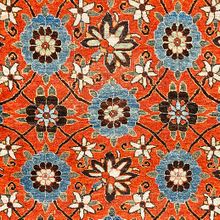Difference between revisions of "Varamin Rug"
Jump to navigation
Jump to search
| Line 42: | Line 42: | ||
== Techniques and structures == | == Techniques and structures == | ||
=== Color and dyeing === | === Color and dyeing === | ||
| + | Early Varamin rugs have deep red or dark blue coloration for the background. These colors are interchangeable for the borders.<ref>Moheban, 2015, p.605</ref><br> | ||
| + | |||
=== Motifs and patterns === | === Motifs and patterns === | ||
=== Weaving techniques === | === Weaving techniques === | ||
Revision as of 08:36, 4 December 2019
| Varamin Rug | |
|---|---|
 Design of Varamin Rug (Rugman) | |
| General information | |
| Name | Varamin Rug |
| Original name | قالي ورامین |
| Alternative name(s) | Varamin Carpet |
| Origin | |
| Category | Village |
| Technical information | |
| Common designs | Vagireh, Afshan |
| Common colors | Blue, Navy Blue, Cream, Red, Beige, Green |
| Dyeing method | Natural, Synthetic |
| Pile material | Wool |
| Foundation material | Cotton |
| Knot type | Asyemmetrical (Persian), Symmetrical (Turkish) |
History
Materials
Foundation and Pile
The rugs have wool foundation and a wool pile.[1]
Techniques and structures
Color and dyeing
Early Varamin rugs have deep red or dark blue coloration for the background. These colors are interchangeable for the borders.[2]
Motifs and patterns
Weaving techniques
See also
References
Bibliography
Abraham Levi Moheban, (2015), The Encyclopedia of Antique Carpets: Twenty-Five Centuries of Weaving, NewYork: Princeton Architectural Press.